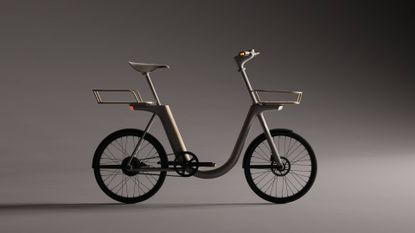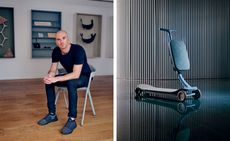Layer's Pendler urban e-bike concept makes a virtue of practicality
Benjamin Hubert and Layer create a cleanly executed concept for the ultimate city e-bike, prioritising safety, practicality, and usability
- (opens in new tab)
- (opens in new tab)
- (opens in new tab)
- Sign up to our newsletter Newsletter

Although new e-bike start-ups are springing up on a monthly basis, the sector has already settled into a relatively consistent aesthetic, a bit smoother and chunkier than a conventional bike, with inspiration more likely to be drawn from mountain bikes than any other genre.

Layer, Benjamin Hubert’s London-based creative agency, has watched the market evolve with interest and frustration. As a riposte to the status quo, the studio has created Pendler, a conceptual urban e-bike pitched at commuters, meticulously designed and carefully shaped to be safer, more practical, and better performing that its rivals.

Pendler is named after the Danish word for commuting (pendling) and is an obvious acknowledgment of that country’s broad and inclusive cycling culture (according to Layer, nine out of ten Danes are bike owners).

The concept design is based around a U-shaped frame, a thick structural element that gives the bike an instantly recognisable silhouette, as well as being very practical for the on-off nature of urban riding.
The studio notes that it’s also a ‘challenge to the conventional performance-driven language of e-bikes’. The frame includes integral lights, front and rear, while indicator lights are mounted on the handlebars.

Although Pendler’s steel frame doesn’t fold, it is still compact – with modest 20in wheels and folding pedals and handlebars to make apartment storage much more practical – as well as being easy to manoeuvre onto public transport where allowed.

Layer has emphasised practicality above all else, suggesting a collection of detachable accessories to improve Pendler’s day-to-day usability. These include front and rear basket attachments made from wire and timber, as well as a mobile phone dock for navigation.
Power comes from a compact 45Nm rear hub motor integrated into the frame, coupled to a removable 250Wh battery. Top speed is around 25km/h, as per current guidelines, and one charge should be good for around 70km.

‘Our aim with Pendler was to envisage a safer, more convenient and effortless mode of personal transport to enable independence for commuting in the city,’ says Hubert. ‘The result is an intelligently designed e-bike that is inclusive, easy to store in compact urban spaces, and balances high performance with a desirable, crafted aesthetic.’
INFORMATION
Pendler Urban e-bike by Layer, concept only
layerdesign.com (opens in new tab)
Jonathan Bell has written for Wallpaper* magazine since 1999, covering everything from architecture and transport design to books, tech and graphic design. He is now the magazine’s Transport and Technology Editor. Jonathan has written and edited 15 books, including Concept Car Design, 21st Century House, and The New Modern House. He is also the host of Wallpaper’s first podcast.
-
 Cerith Wyn Evans: ‘I love nothing more than neon in direct sunlight. It’s heartbreakingly beautiful’
Cerith Wyn Evans: ‘I love nothing more than neon in direct sunlight. It’s heartbreakingly beautiful’Cerith Wyn Evans reflects on his largest show in the UK to date, at Mostyn, Wales – a multisensory, neon-charged fantasia of mind, body and language
By Harriet Lloyd-Smith • Published
-
 Nifemi Marcus-Bello is the Nigerian designer shaping Africa’s designscape
Nifemi Marcus-Bello is the Nigerian designer shaping Africa’s designscapeAmong Wallpaper’s ‘Future Icons’, Lagos-based designer Nifemi Marcus-Bello speaks of creating a local manufacturing network and documenting design production in Africa
By Ugonna-Ora Owoh • Published
-
 Luxury loungewear brands to hibernate in this winter
Luxury loungewear brands to hibernate in this winterAs days get shorter and temperatures drop, we present the best loungewear for luxuriating in this autumn and winter, from brands including Loro Piana, Raey, Extreme Cashmere and more
By Tilly Macalister-Smith • Published



